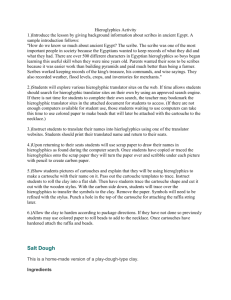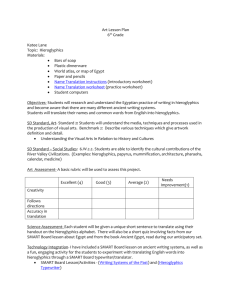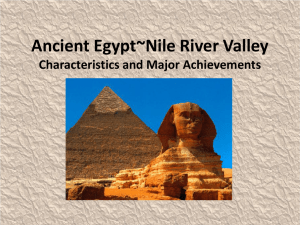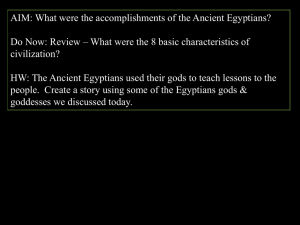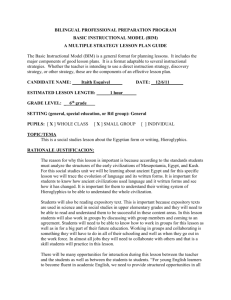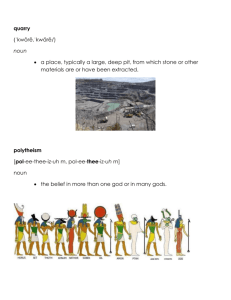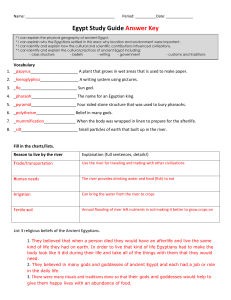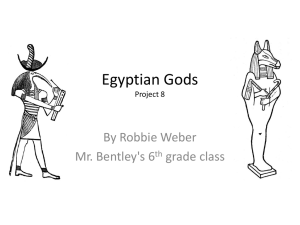Mundrick & Van Der Molen_Day Nine
advertisement
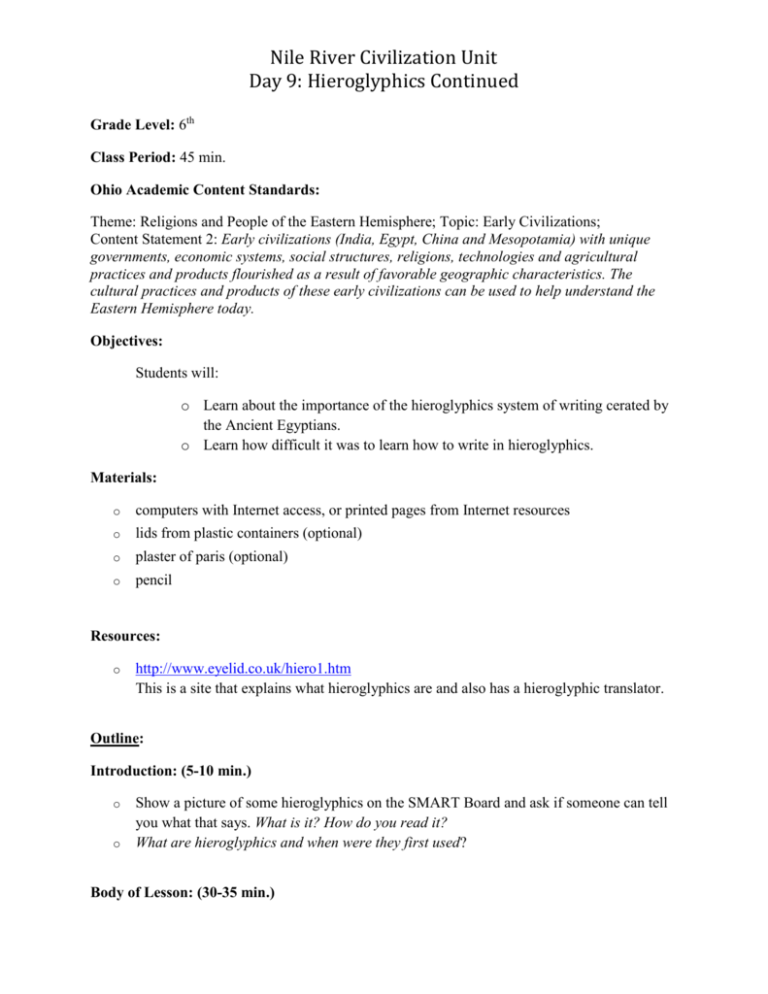
Nile River Civilization Unit Day 9: Hieroglyphics Continued Grade Level: 6th Class Period: 45 min. Ohio Academic Content Standards: Theme: Religions and People of the Eastern Hemisphere; Topic: Early Civilizations; Content Statement 2: Early civilizations (India, Egypt, China and Mesopotamia) with unique governments, economic systems, social structures, religions, technologies and agricultural practices and products flourished as a result of favorable geographic characteristics. The cultural practices and products of these early civilizations can be used to help understand the Eastern Hemisphere today. Objectives: Students will: o Learn about the importance of the hieroglyphics system of writing cerated by the Ancient Egyptians. o Learn how difficult it was to learn how to write in hieroglyphics. Materials: o computers with Internet access, or printed pages from Internet resources o lids from plastic containers (optional) o plaster of paris (optional) o pencil Resources: o http://www.eyelid.co.uk/hiero1.htm This is a site that explains what hieroglyphics are and also has a hieroglyphic translator. Outline: Introduction: (5-10 min.) o o Show a picture of some hieroglyphics on the SMART Board and ask if someone can tell you what that says. What is it? How do you read it? What are hieroglyphics and when were they first used? Body of Lesson: (30-35 min.) 1. Go to http://www.eyelid.co.uk/hiero1.htm and read about the history of hieroglyphics. 2. Provide students with a printed reference about the hieroglyphics of ancient Egypt. (Students with online access can view the sources online.) Each reference should offer a key to the common hieroglyphic symbols and their sounds/pronunciations. Following are a handful of online resources that might be used: Neferchichi's Tomb: Writing With Hieroglyphics Hieroglyphic Alphabet Chart A Short Introduction to Hieroglyphs Egyptian Hieroglyphics 3. Have students cut or trace symbols from these resources to spell/write/draw their names. 4. Talk about the fact that: The Ancient Egyptians created their own system of writing using a series of images to share and record information called hieroglyphics. It is believed that Egyptians first started developing hieroglyphics around 3000 B.C. Because there are over 700 symbols representing actual words and thousands more that represent individual sounds learning how to write in hieroglyphics was no easy task. Unlike most forms of modern language, ancient Egyptian hieroglyphics could be read either from right to left or from left to right. To know which direction to begin reading, the scribe would position the figures/images so that they faced in the correct direction. Hieroglyphics were merely used on buildings and tombs at first but were later used to decorate jewelry and, perhaps most importantly, record events on papyrus (a type of paper). 5. The Ancient Egyptians used the art of hieroglyphics to record their history. This is how we know so much about them today. 6. When we talk about how history is recorded, we call that historiography. What are some things that would affect the Ancient Egyptians ability to accurately record their history? 7. Have students brainstorm some ideas at their seats individually for 1 minute. 8. Ask students the following questions and see what type of discussion follows: What are some things that would limit the Ancient Egyptians by using hieroglyphics? How do they convey emotion in their writing? How do they signal punctuation? Does every word or thought we have fit into a symbolic representation? Are there multiple ways to convey the same idea? How many people can actually read what they write? 9. Spend the last 10 minutes of class presenting Artifact Boxes. Extension activities: Have students use the hieroglyphics alphabet to write a sentence. Then ask them to translate one another's sentences. Introduce students to such online tools as the Egyptian Name Translator or the Online Hieroglyphics Translator, in which students can get the hieroglyphics translation of a word or name. For each student, fill the lid of a plastic container with plaster of paris. Before it dries, allow the student to use the tip of a pencil to carve into the plaster his or her name or a message. When the plaster is dry, students will have their own Rosetta stones. Closure: (3 min.) 1. For homework, students are going to write a journal entry. This time their prompt is: “Pretend you are the new pharaoh. Argue either for or against using hieroglyphics as your main form of written communication. Tell why you chose your stance. How does this affect your ability to record history? What other factors might hinder the ability to record historical events accurately?” Assessments: o Students use their hieroglyphic pronunciation keys to translate a grade-appropriate word, phrase, or sentence from English into hieroglyphs and from hieroglyphs into English. o Class discussion and student responses. o Observe students’ participation in group work and discussions about the art of writing in hieroglyphics. o Evaluate the journal response and assess using the journal response rubric. o Evaluate Artifact Presentations. Journal Response Rubric Name/Number Date Spelling Punctuation Grammar Capitalization Answer to the Prompt Length 1 Has a name, number or date on journal response. 2 Response contains only 1-2 errors. 5 Response answers the prompt completely by giving a detailed explanation. 4 3 Response answers the prompt with some detail and explanation. 2 Response is required length. 0 Does not have a name, number or date on journal response. 1 Response has multiple errors. 2 1 Response is answered but contains little detail and explanation. 0 Response may or may not be answered and has no detail or explanation. 1 Response is only one sentence long. Artifact Box Rubric Artifacts/Creativity 10 Points Presentation (5 minutes max) 10 Points Engaging the Audience 5 Points Box contains 5 or more appropriate artifacts • Artifacts clearly represent various aspects of the chosen aspect of Ancient Egyptian life • Box creatively and neatly organized. 10; 9;8 Begins with an introduction and description of the assigned aspect of daily Egyptian life. Research is evident. Provides handout for other students. • • • 10; 9; 8 Well articulated Audience was engaged. Artifacts visible. Speaks clearly and with enthusiasm. 5;4 Box contains at 4 appropriate artifacts • Artifacts clearly represent various aspects of the assigned River Civilization • Box shows some creativity and organization 7;6 Begins with an Introduction to research but no description of the assigned aspect of daily Egyptian life. Some research is evident. Provides handout for other students. • • • • 7; 6; 5 Somewhat articulate Audience was somewhat engaged. Artifacts somewhat visible. Speaks clearly, sometimes speaks with enthusiasm 3 Box contains less than 3 artifacts • Artifacts do not appropriately represent various aspects of the assigned River Civilization • Box lacks creativity and neatness 5;4 Does not introduce/describe the assigned aspect of daily Egyptian life. Little/no research is evident. Does not provide handout for other students. 4; 3; 2; 1 Difficulty with articulation • Audience not engaged. • Cannot see artifacts. • Lacks enthusiasm/speaks in monotone and not clear. 2; 1
